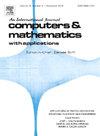基于高阶切比雪夫频率响应建模的多相复合材料壳体混合主动被动控制
IF 2.5
2区 数学
Q1 MATHEMATICS, APPLIED
引用次数: 0
摘要
本文提出了一种利用高阶切比雪夫有限元进行多层复合材料壳控制频响分析的高效方法。本研究中使用的复合材料的一个关键特征是其三相组成,由聚合物基体、碳纤维和嵌入在基体相中的碳纳米管纳米填料组成。碳纳米管纳米填料的加入显著提高了整体材料的力学和动态性能。该方法解决了剪切/膜锁定和离散分层模型的计算费用问题,确保了分析复杂复合材料壳体的效率和精度。该方法采用由切比雪夫多项式衍生的高阶形状函数,在不牺牲精度的前提下实现了快速收敛。开发的数值模型捕获了不同几何构型层压壳的频率响应,同时结合了引入主动或被动阻尼的两层控制补丁的影响。此外,该模型考虑了复合材料的分层效应,从而可以准确预测受激载荷作用下的结构行为。数值验证证实了高阶切比雪夫有限元的鲁棒性和通用性,有效地克服了锁模和杂散模等常见的计算挑战,同时为实际工程应用提供了高度准确和可靠的频率响应预测。这项研究强调了将先进的数值技术与创新的复合材料相结合,以改善航空航天、汽车和土木工程应用中的动态性能的潜力。本文章由计算机程序翻译,如有差异,请以英文原文为准。
Hybrid active-passive control of multiphase composite shells through high-order Chebyshev frequency response modeling
This paper presents a high-efficiency approach for controlled frequency response analysis of laminated multi-phase composite shells, employing high-order Chebyshev finite elements. A key feature of the composite material used in this study is its three-phase composition, consisting of a polymer matrix, carbon fiber, and carbon nanotube nanofillers embedded within the matrix phase. The inclusion of carbon nanotube nanofillers significantly enhances the mechanical and dynamic properties of the overall material. The proposed approach addresses shear/membrane locking and the computational expense of discrete layerwise models, ensuring both efficiency and precision in analyzing complex composite shells. By using high-order shape functions derived from Chebyshev polynomials, this approach achieves rapid convergence without sacrificing accuracy. The developed numerical model captures the frequency response of laminated shells across varying geometric configurations, while incorporating the effects of two-layer control patches that introduce active or passive damping. Additionally, the model accounts for the layerwise effect of the composite, allowing for accurate prediction of structural behavior under excited loads. Numerical validation confirms the robustness and versatility of the high-order Chebyshev finite elements, effectively overcoming common computational challenges such as locking and spurious modes, while providing highly accurate and reliable frequency response predictions for practical engineering applications. This study highlights the potential of using advanced numerical techniques in combination with innovative composite materials for improved dynamic performance in aerospace, automotive, and civil engineering applications.
求助全文
通过发布文献求助,成功后即可免费获取论文全文。
去求助
来源期刊

Computers & Mathematics with Applications
工程技术-计算机:跨学科应用
CiteScore
5.10
自引率
10.30%
发文量
396
审稿时长
9.9 weeks
期刊介绍:
Computers & Mathematics with Applications provides a medium of exchange for those engaged in fields contributing to building successful simulations for science and engineering using Partial Differential Equations (PDEs).
 求助内容:
求助内容: 应助结果提醒方式:
应助结果提醒方式:


